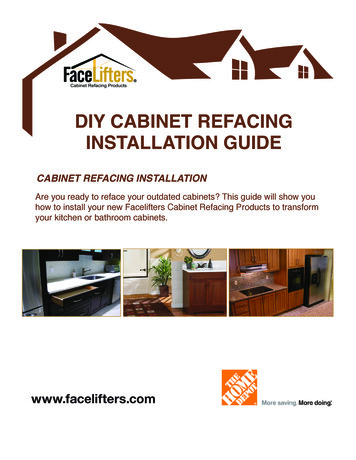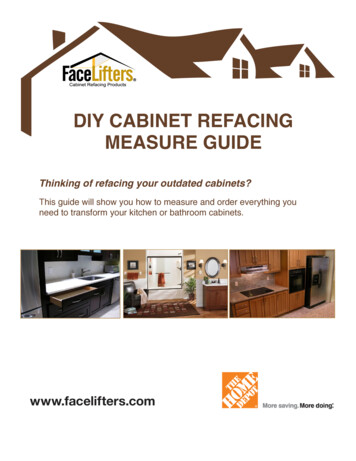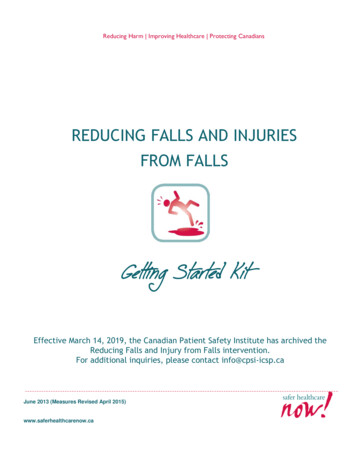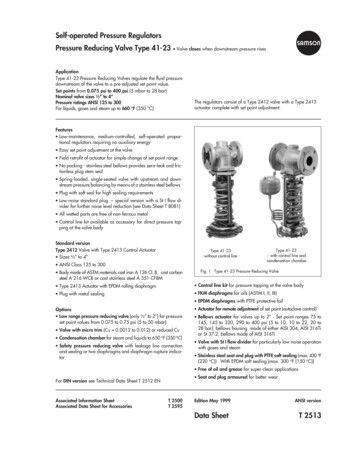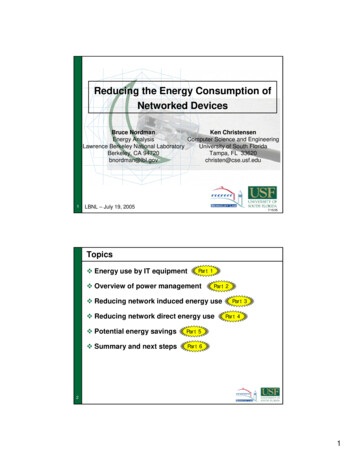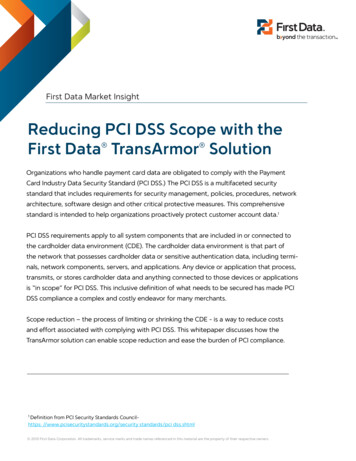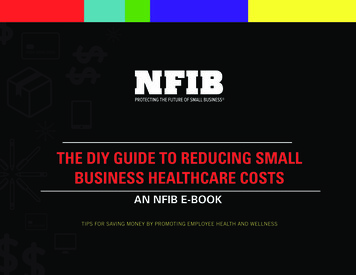
Transcription
THE DIY GUIDE TO REDUCING SMALLBUSINESS HEALTHCARE COSTSAN NFIB E-BOOKTIPS FOR SAVING MONEY BY PROMOTING EMPLOYEE HEALTH AND WELLNESS
OVERVIEW3Healthy Employees, Healthy Business4How to Implement an Employee Wellness Program5Eating at the Office6Competing for Better Health7Healthy NFIBTwitter.com/NFIB
HEALTHY EMPLOYEES, HEALTHY BUSINESSAs a small business owner, you have dozens of competing priorities, and implementingan employee wellness program might not be at the top of the list. But research shows thatfocusing on this issue is in employers’ best interest.According to the CDC Foundation, work-related injuries and illnesses, chronic diseases andpain, absenteeism, and employees who show up to work sick cost U.S. employers billionsof dollars each year. Additionally, health issues like depression, fatigue, and stress drive upemployers’ medical costs and hamper workforce productivity.However, when employers place a priority on wellness and employees improve theirhealth as a result, productivity rises. For example, a recent study of workers at Midwesterncommercial laundry plants found that implementation of an employer-sponsored healthprogram had a 76.3 percent return on investment, The Wall Street Journal reported. Thestudy’s authors primarily credit lifestyle changes—including improved nutrition, moreexercise, and less stress—for the improvements, but also noted that the staff workedharder because the employer demonstrated care for their well-being.OrthoCarolina, a Charlotte-based orthopedics group, found similar positive results from itsnationally recognized Be Well corporate wellness program. Not only has the program helpedsave the company 1.2 million per year since 2014 in employee healthcare costs, but itsees a 1.50 to 2 return for every dollar the company spends on the program.“In addition to the financial return, our staff is more engaged, more productive, and hasincentives in place to manage and improve their health,” says Jason Boudrie, wellnessdirector for k.com/NFIBTwitter.com/NFIB
HOW TO IMPLEMENT AN EMPLOYEEWELLNESS PROGRAM1. LEAD BY EXAMPLEIf you’re stressed out, fatigued, subsisting on vending-machine food, and strugglingwith your own chronic pain or diseases, speeches about the importance of wellnesswon’t mean much.“Promoting a positive health and wellness culture begins with accepting yourown areas for improvement,” says Sarah Frances Robbins, a mental health nursepractitioner and owner of Precision Mental Performance, a small online therapypractice. “Being honest and transparent with employees begins to build trust withinthe corporate climate. Once the culture begins to shift toward health, then thecompany will begin to see less burnout, less turnover, happier customer service,and fewer sick days, which will make the company more desirable for highlyqualified applicants.”Demonstrating that healthy living is important to you is the first step to gainingemployee buy-in for a workplace wellness program.2. SURVEY YOUR STAFFA wellness program only works if employees participate, so involve your staff in theprocess to find out what benefits and components are most valuable to them.At ResumeGo, a small company offering career coaching and resume writing services,co-founder Peter Yang used an initial interest survey to gain employee feedback onwellness program benefits, which now include nutrition seminars, a healthy officekitchen, subsidized gym memberships, and Health Reimbursement Arrangementcontributions. While each person’s health priorities were different, Yang and hispartners included a variety of perks to benefit everyone in some way. They alsocontinue to solicit feedback with quarterly surveys to modify the program over time.Andrew Cavenagh, managing director of Pareto Captive Services, which helps midsize businesses self-insure and customize their health plans, says to consider thespecific needs of employees and the overall health of the group when designinga wellness program. Anthony Evans, president of business development at HenryInvestment Group and one of Pareto’s clients, noted that this approach helped themdiscover where employees needed better health access and information and createa health plan structure to fit those needs.“The overall key is to know and analyze your company,” Cavenagh says. “There isn’t aone-size-fits-all wellness program for all .com/NFIBTwitter.com/NFIB
EATING AT THE OFFICENot only does food directly impact mood and energy levels, affecting productivity,but poor nutrition is also the root of countless chronic diseases, says Susan Stalte,a registered dietitian and owner of an online corporate nutrition consulting business.Many people underestimate the true power of the foods they opt for each day, sheadds, and while they want to eat well, they don’t know which foods to buy or they setunrealistic nutrition goals that don’t set them up for success.HEALTHY SNACK IDEAS String cheese or Babybel cheese“If a business can equip an employee with the knowledge necessary to make healthychoices, it can cut down on healthcare spending and time away from the office,”Stalte says. Cottage cheese Siggi’s or Fage Greek yogurt Hard-boiled eggsYour company can promote healthy eating in a variety of ways. Try: Hummus StarKist tuna salad packs Oberto beef jerky Raw vegetables, such as snap peas,cucumbers, and sweet pepper slices Fruit, such as bananas, apples,and oranges Raw nuts, such as pistachios,almonds, and cashews Roasted chickpeas Applesauce packets Beanitos chips Air-popped popcorn Mary’s Gone Crackers Fig Newtons Justin’s individual nut butter packets Dark chocolate (the higher thepercentage, the better) Stocking the fridge and vending machine with healthy snack options likewater, fruits, vegetables, nuts, and yogurt instead of soda, chips, and candy. Hosting a regular healthy staff lunch, either catered or potluck. Offering learning opportunities, such as talks on nutrition or a healthy cookingdemonstration.ou can even tie these in with the hosted lunches above!To help you stock your office kitchen with healthier items, registered dietitianSusan Stalte recommends these options:HEALTH BARS, SUCH AS: Primal Kitchen Dark ChocolateAlmond bars Zing bars RXBars Perfect Bar mini’s Health Warrior Chia bars KIND barsSNACK PAIRINGS: Small piece of fruit with either twostring cheese sticks, ½ cup of cottagecheese, or two handfuls of nuts Snap peas with two string cheesesticks or two handfuls of nutsMedjool dates Greek yogurt with raw nuts and berriesEzekiel toast Roasted chickpeas with two stringcheese sticks or Babybel cheeses Two medjool dates with 1 tablespoonof nut butter Ezekiel toast with 2 tablespoons ofnut butter and a half banana on top Mary’s Gone Crackers with cottagecheese or hummus and cucumberslices on witter.com/NFIB
COMPETING FOR BETTER HEALTHAnother important factor in improving employee health is getting more exercise.A sedentary lifestyle can lead to weight gain and numerous chronic diseases—youlikely remember a rash of headlines in recent years that proclaimed, “sitting is thenew smoking” and “sitting will kill you.” Your company may not be able to affordsubsidized gym memberships or standing desks for all employees, but a littlefriendly competition can go a long way toward encouraging your staff to be moreactive. Consider sponsoring your employees’ participation in a charity run or walkevent, host a staff 5K race or company picnic/field day, or institute a weight-loss orstep-counting challenge.At OrthoCarolina, employees earn points—and then cash or Health Savings Accountbonuses—based on their participation and progress in programs focused onachieving measurable, individual results. Your business may be able to implementa similar program with an employee wellness app, such as Jiff, LifeWorks, Limeade,or Virgin Pulse.“Working in competitions and games can be a great way to incentivize employees,”says Aaron Hackett, doctor of physical therapy and owner of Aevitas, a smallbusiness that provides corporate wellness consulting. “It’s always amazing howsomething as little as a 30 movie gift card or employee of the month parkingspot can really spark participation.”Hackett advises keeping it fun, focusing on being active and healthy rather than onbody image, and making sure the nature of the competition doesn’t exclude FIBTwitter.com/NFIB
HEALTHY BENEFITSDepending on employee input and feedback, your company’s wellness program couldoffer a wide variety of benefits—from smoking-cessation programs to health fairs andhealth screening events to on-site fitness classes or subsidized gym memberships—that will help them make healthy lifestyle changes. But don’t overlook simple, lowor no-cost benefits that promote balance and well-being.“Allowing a late-start day or a chance to leave early can be huge in someone’s day,”Hackett says. “It can mean missing [traffic] gridlock or a chance to eat breakfastwith their kids. An extra 15-minute break during work could mean a nice walk aroundthe building, a relaxing talk with co-workers, or even a power nap. These cost thecompany little to nothing, but mean a great deal to an employee. It also shows theemployer understands that life can be hard and stressful, and we all need a break.”HOW NFIB CAN HELP WITH HEALTHCARE COSTSThe tips in this e-book can help you establish a successful employee wellness programthat reduces long-term costs, but NFIB can also help you find the best health insurancecoverage for yourself and/or your employees. With the assistance of the NFIB HealthInsurance Exchange, shop for insurance 1 options like Term Medical2 and Fixed IndemnityPlans. These non-ACA/non-Obamacare plans can provide greater savings, better accessto care, and medical insurance with up to 2 million in lifetime benefits. If you’re not inthe market for a health insurance plan right now, but are interested in supplementalcoverages to round out your or your employees’ insurance needs, the NFIB HealthInsurance Exchange is also the place for accident, dental, critical illness plans, and more.Plans are enrolled by AHIX.com, a division of JLBG Health. Plans are not available in all counties/states. Check website for more details. In somecases we are unable to enroll you in an ACA plan because of contractual agreements. In this case you will be directed to a government website toenroll. Per ACA Presidential Executive order signed Jan 20th, 2017. JLBG/AHIX does not give tax advice. Please consult your tax professional formore details.1VISIT NFIBHEALTHPLANS.COM TOLEARN MORE OR GET A FREE QUOTE.NFIBNFIB.com/HealthyBenefitsTerm Medical Plans (Non-Obamacare plans) are medically underwritten and do not cover preexisting conditions. These plans do not meet the minimum essential coverage requirements under the Affordable Care Act (ACA), and may result in a tax penalty. Contact your tax advisor for more details.Availability may vary by state and certain state exclusions may apply.2This NFIB Member benefit is offered pursuant to contracts that NFIB’s affiliates, including MSC Insurance Agency of Tennessee, LLC (the “Agency”),have with various insurance companies (the “Program”). The Agency is a licensed insurance producer (CA License #0C77420/TN License #47);however, insurance related to the Program is offered through the various insurance companies that have contracted with the Agency and not throughNFIB or the Agency. NFIB membership does not guarantee insurance coverage and not all members will qualify for coverage.Facebook.com/NFIBTwitter.com/NFIB7
Andrew Cavenagh, managing director of Pareto Captive Services, which helps mid-size businesses self-insure and customize their health plans, says to consider the specific needs of employees and the overall health of the group when designing a wellness program.
